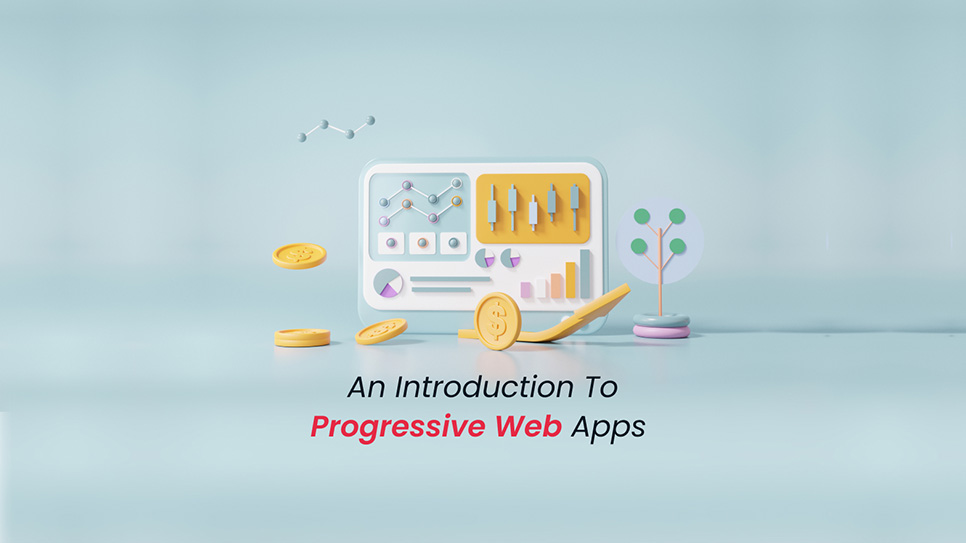An Introduction To Progressive Web Apps

It’s no secret that efficiency and performance are critical for any online business. As a result, a new standard known as Progressive Web Apps is being used by numerous websites across industries to increase their efficiency.
The front-end solution, which is backed by Google, seeks to offer good performance independent of device or network state. They accomplish this by imbuing PWAs with native-app features like dependability, speed, and engagement. PWAs are a novel concept for most people, but they’re getting a lot of traction.
So, in this blog, we’ll learn about PWAs and get a quick overview of some of the best examples of PWAs.
What are Progressive Web Apps (PWAs) and why are they being developed?
A Progressive Web App (PWA) is a typical web app that is gradually improved using open web standards to ensure that it provides the best possible experience on all devices based on the current availability of features and capabilities.
Users on current browsers and newer devices will enjoy an upgraded experience that competes with the platform-specific (installed) applications on that platform, while users on older browsers and devices will continue to have a usable experience in the form of familiar webpages.
Progressive Web Apps may thereby combine the reach (wide availability and access) of website experiences with the capacity (hardware features and rich resources) of platform-specific experiences.
What are the three major pillars of PWAs?
1) Capability
We all know how powerful the internet is on its own. PWAs have access to new and forthcoming APIs and features that were previously exclusively available to platform-specific apps. With capabilities like file system access, media controls, app badging, and complete clipboard support, the web can do more.
All of these capabilities are made possible by the web’s secure, user-centric authorization architecture, which ensures that users never have a terrifying experience while accessing a website.
2) Reliability
Regardless of the network, a solid Progressive Web App feels quick and reliable. Applications that are dependable must be usable regardless of network connectivity. Users want apps to start up even while connected to a sluggish or unstable network, or even when they are offline. Even if sending a request to your server is difficult, customers want the most recent stuff they’ve dealt with, such as media tracks, tickets, and itineraries, to be available and usable. When a request isn’t feasible, they want to be informed of the problem rather than the request failing or crashing quietly.
3) Installabilty
Progressive Web Apps are installed and operate in a separate window rather than a browser tab. They may be launched from the user’s home screen, dock, taskbar, or shelf, among other places. It’s possible to find them on a device and switch between them using the app switcher, giving them the impression that they’re a part of it. New features become accessible once a web app is installed.
Progressive Web Apps can be set up to accept content from other apps or to be the default app for handling certain file formats.
When Should You Use Progressive Web App?
Apps provide better experiences than online applications, which is one of the reasons why people choose them. However, building and maintaining native apps takes a lot of time and money.
You must code your app for each platform if your consumers use different platforms.
PWAs, on the other hand, do not necessitate coding for each platform. They were created with the “code once, use everywhere” mentality in mind. Your PWA may be utilized in-browser (as a website or web app), on desktops, and on mobile devices once you’ve finished coding it.
This frequently leads to greater performance, higher retention rates, and, ultimately, a cost-effective application that provides a good user experience to your users (UX).
Some Of The Leading Progressive Web Apps Examples
1) BMW
BMW, as a forerunner in the automobile business, demonstrates that they aren’t afraid of new technology, whether it’s in their cars or on their website. The brand wanted to improve the consumer experience by providing high-quality, engaging content that reflected their beliefs.
The new BMW PWA provides consumers with a ‘wow’ experience. The high-resolution images and videos are the first thing that everybody notices, and the website loads almost swiftly with all of these elements.
2) Uber
Uber, the ride-hailing firm, recognized an opportunity to grow its user base by developing a progressive web app that makes requesting trips easier and faster. Regardless of location, network speed, or device, the PWA works flawlessly.
3) Starbucks
Starbucks created a PWA of the ordering system on the web, which provides a decent experience to their current native app, in order to provide all of their customers with accessible, user-friendly online ordering. To put it another way, the Starbucks PWA’s ability to work offline allows users to browse the menu, make changes to their orders, and add items to their shopping carts.
4) Flipboard
Flipboard is a must-have for everyone who enjoys staying up to date on global news and trends. Flipboard created a Progressive Web App (PWA) to expand its reach and provide people access to its favorite online magazine.
Conclusion:
The future of online browsing is progressive web applications. More than that, they may represent the future of the e-commerce consumer experience.
That is why you should spend on creating one for your business.
If you want to create a Progressive Web App, our team has the knowledge and experience to make it happen. When it comes to web app development, we at LN Webworks meet the expectations of any business.

